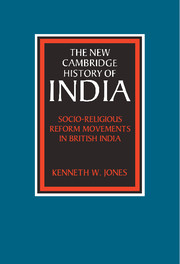Book contents
- Frontmatter
- 1 Concepts and context
- 2 Bengal and north-eastern India
- 3 The Gangetic core: Uttar Pradesh and Bihar
- 4 Punjab and the north-west
- 5 The central belt and Maharashtra
- 6 The Dravidian South
- 7 The twentieth century: socio-religious movements in a politicized world
- 8 Conclusion: religion in history
- Glossary of Indian terms
- Bibliographical essay
- Index
- THE NEW CAMBRIDGE HISTORY OF INDIA
- References
3 - The Gangetic core: Uttar Pradesh and Bihar
Published online by Cambridge University Press: 28 March 2008
- Frontmatter
- 1 Concepts and context
- 2 Bengal and north-eastern India
- 3 The Gangetic core: Uttar Pradesh and Bihar
- 4 Punjab and the north-west
- 5 The central belt and Maharashtra
- 6 The Dravidian South
- 7 The twentieth century: socio-religious movements in a politicized world
- 8 Conclusion: religion in history
- Glossary of Indian terms
- Bibliographical essay
- Index
- THE NEW CAMBRIDGE HISTORY OF INDIA
- References
Summary
THE SETTING
The vast northern plain of the Ganges-Jumna River system stretches from the banks of the Jumna River south-east to the edges of Bengal. To the North are the foothills and behind them the great barrier of Himalayan mountains. The southern borders of this plain are marked by another range of hills that merge into the Vindhya mountain chain, the line of demarcation between northern India and the Deccan plateau of the South. Within this geographic area evolved the Hindu-Buddhist civilization, beginning in the second millennium before Christ. After the conquest of northern India by Islamic armies, it also became the hub of Indo-Muslim civilization. This vast plain repeatedly provided the population and productivity needed to build and sustain major kingdoms and empires.
The population of the Gangetic basin reflects its history. Hindus live throughout the plains and foothills. Their society possessed a complex caste system encompassing all of the traditional varnas along with innumerable divisions of specific castes and sub-castes. Hindus predominated with 86 per cent of the population, while the largest minority were the Muslims with 13.7 per cent. The Muslim population, however, showed distinctly different characteristics from the Islamic community of Bengal. In the North-Western Provinces they accounted for 38 per cent of the urban population. More concentrated in the cities and towns of the West, Muslims encompassed over 50 per cent of the urban dwellers in the area of Rohilkhand. Bihar held an even smaller percentage of Muslims; nevertheless, it too had a significant concentration of them in its towns and cities.
- Type
- Chapter
- Information
- Socio-Religious Reform Movements in British India , pp. 48 - 84Publisher: Cambridge University PressPrint publication year: 1990

